|
|
|
|
|
S. M. S. HYAENE
 |
|
This is a cap tally from the Werft personnel serving on the
1878 steam and sail gunboat, SMS Hyäne (hyena).
In 1882 the Hyäne set off on an expedition to
the South Seas including the colony of New Guinea. She also took
part in the founding of Swakopmund in German South West Africa
after land Hauptmann Curt von François there in
SMS Hyäne twice saw action in Cameroon.
During the Abo
Rebellion of 1891 (alongside the gunboat SMS Habicht) and in the
the Dahomey Slaves Rebellion of 1893. On both occasions she bombarded rebel villages
and landed armed sailors.
She did not see action in the
First World War and after the war it was sold as a merchant
vessel and sank in Dieppe in 1924 after a cargo fire.
Recommended External Links-
Medal Net - Cameroon 1891
&
Medal Net -
Cameroon 1893
|
|
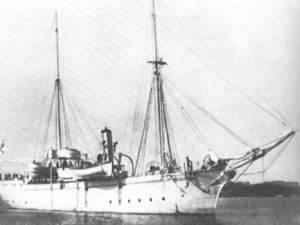
SMS
Hyäne
Photo from
Wikimedia |
|
|
|
|
|
S. M. S. MOEWE
 |
|
This is a cap tally from the
Matrosen personnel serving on the SMS Möwe (seagull). There were
three German ships in the Imperial era with this title, all of which saw
overseas service. The first was a
Habicht class gunboat launched in 1879. It was appointed to the German
West Africa Squadron and took part in the establishment of Cameroon as a
German colony in 1884. In 1888-89 it was part of the German fleet
deployed to East Africa to crush the Abushiri Rebellion and in 1895 was
deployed to German New Guinea. She was withdrawn from service in 1905.
Recommended External Links-
Medal Net - German East Africa 1888-89 and
Deutsche-Schutzgebiete - SMS Moewe
The second was an armed survey ship
launched in 1905. She surveyed the coast of New Guinea but at the
outbreak of the First World War she was stationed off East Africa. She
was scuttled in Dar Es Salaam harbour and her guns and crew served on
land and on Lake Tanganyika with the Schutztruppe.
The third SMS Möwe was a former
freightliner named Pungo, which was equipped as a minelayer and armed
raider in 1916. On two raiding missions she captured or sank forty
allied vessels. After the war she continued in use as a freightliner
renamed the Oldenburg and was sunk by British aircraft off the coast of
Norway in 1945.
|
|
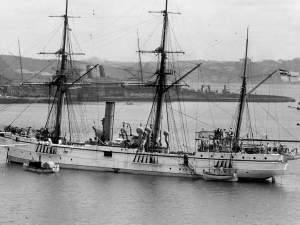
The first SMS Möwe in Sydney Harbour
Photo from
thy
William Hall collection, Australian National Maritime Museum/
WikiCommons |
|
|
|
|
|
(S. M. S.) ADLER
 |
|
This is a cap tally from the
Matrosen personnel serving on the SMS Adler (eagle). Note the the
letters SMS before the ship's name were not used before
1890.
SMS Adler was a Habicht class gunboat
launched in 1883 and served in the Samoan Crisis in 1888 when
about 150 sailors from the Alder, SMS Olga and SMS Eber were landed near Apia to
confront Samoan rebels under King Mataafa at the Battle of Vailele. The Adler was
wrecked in a storm off Apia in 1889. |
|
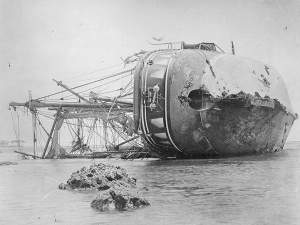
Wreck of the SMS Adler, Apia 1889
Photo from U.S. Naval Historical
Center /
WikiCommons |
| |
|
|
|
S. M. S. SCHWALBE
 |
|
This is a cap tally from the
Matrosen personnel serving on the SMS Schwalbe.
The SMS
Schwalbe (swallow) was a Schwalbe class unprotected cruiser
launched in 1887. She first served off East Africa during the Abushiri Rebellion
in 1888, providing coastal blockade, artillery bombardment
and landing parties to help put down the rebellion alongside SMS
Leipzig, SMS Möwe,
SMS Pfeil, SMS Sophie, SMS Carola and SMS Olga.
In 1900, during
the Anglo-Boer War, SMS Schwalbe returned to African waters
to protect German merchant ships from the British Royal Navy.
The Royal Navy had seized several German vessels causing a
diplomatic incident but the threat of war was averted. The
Schwalbe then sailed for China to assist in the Boxer Rebellion
and took part in the blockade of the River Yangtze. She returned
to Germany in 1902 for repairs and was put on the naval reserve.
During the First World War she did not see active service and
was used as a floating barracks. SMS Schwalbe was scrapped in
1922. |
|
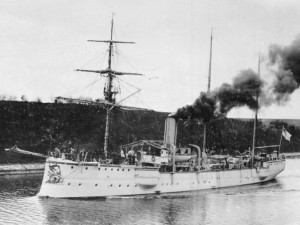
SMS Schwalbe
Photo from
Wikipedia/Bundesarchiv |
| |
|
|
|
S. M. S. BUSSARD
 |
|
This is a cap tally from the
Matrosen personnel serving on the SMS Bussard (buzzard). SMS Bussard
was an unprotected cruiser of the Bussard class launched in
1890. The Bussard class were the last ship of the Imperial Navy
to be equipped with auxiliary sails in addition to their steam
engines. There were six ships of the Bussard class, the other
five being SMS
Falke, SMS Seeadler, SMS Cormoran, SMS Condor and SMS Geier.
All six saw service overseas. SMS
Bussard first served in the East
Asian division where she saw action against a local uprising on
Samoa in 1893. She also saw action at the Storming of the Taku
Forts during the Boxer Rebellion in 1900. In 1902 she was transferred to
East Africa where during the Maji-Maji Rebellion, she assisted the Schutztruppe by
ferrying troops up and down the coast of German East Africa to
the rebellious areas. Landing parties of sailors from the ship
were also used to secure the ports. She returned to Germany in
1910 and was scrapped in 1913. |
|
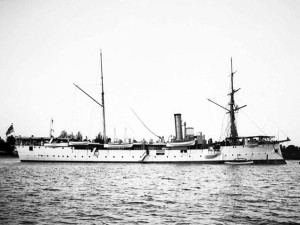
SMS Bussard
Photo
©
Frankfurt University Archive |
| |
|
|
|
S. M. S. SEEADLER
 |
|
This is a cap tally from the
Werft personnel serving on the SMS Seeadler (sea eagle). There
were two ships named Seeadler.
The first was an unprotected
cruiser of the Bussard class launched in 1892. She saw the longest
continuous overseas service of any major ship
in the Imperial German navy, visiting New York in 1893, then
being based in East Africa and New Guinea and seeing action in
both the Maji-Maji Rebellion in East Africa 1905-06 and the
Boxer Rebellion in China. Her last posting was to the coast of
East Africa until January 1914, when she was replaced by the SMS
Königsberg. The Seeadler was retired from service and used to
store mines. She was destroyed in an accidental explosion in
1917.
Recommended External Link
- Article on
Traditionsverband on
SMS Bussard im Maji-Maji Aufstand
The second Seeadler was a
captured American three masted sailing ship converted to use as
commerce raider in 1916. She has a successful career capturing
fifteen allied vessels until she was wreck off French Polynesia
in 1917. |
|
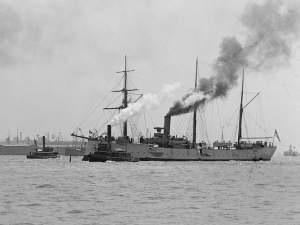
The Cruiser SMS Seeadler, New
York 1893
Photo from
WikiCommons |
| |
|
|
|
S. M. S. COMORAN
 |
| These are two
cap tallies from the Matrosen and Werft personnel serving on the
SMS Cormoran (cormorant) .
The Cormoran was a Bussard class
unprotected cruiser launched in 1892. She was assigned to the
East Asia station in 1894 and took part in the occupation of
Kiautschcou and Tsingtao in 1897, the Samoan Crisis of 1898, the
Boxer Rebellion of 1900 and after modernisation in Germany, in
the
Sokehs Rebellion on Ponape in New Guinea in 1910-11.
When The First World War broke
out she was unfit for action and under going repairs in
Tsingtao. Her guns and crew were first deployed on the captured
Russian vessel Ryazan, then later used on the land defences. The
Cormoran was sctulled in Tsingtao Harbour and the crew became
prisoners of the Japanese after the fall of the city. |
|
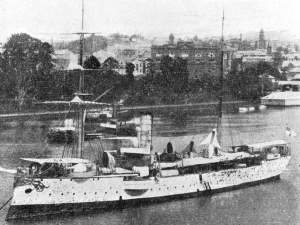
SMS Cormoran, Brisbane 1901
Photo from the
John Oxley Library, State Library of Queensland/WikiCommons |
| |
|
|
|
S. M. S. HERTHA
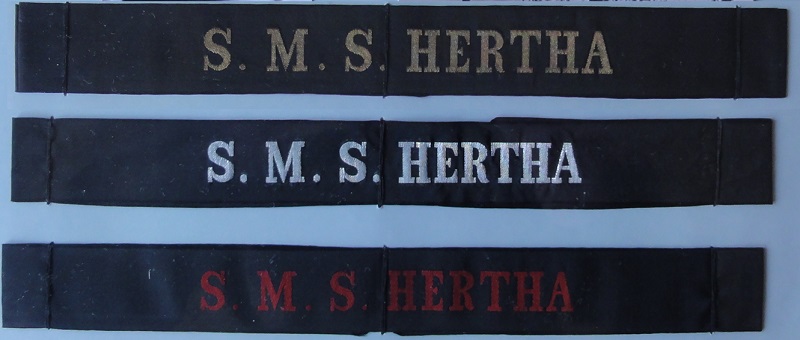 |
|
These are three cap tallies from the
Matrosen, Werft and
Schiffsjunge (ships' boys in red)
serving on the SMS
Hertha.
SMS Hertha was a protected cruiser of the
Victoria Louise class launched in 1897. She served in the East
Asia Squadron and during the Boxer Rebellion of 1900 along with SMS Hansa, SMS
Iltis and SMS Gefion bombarded the Taku Forts. Her sailors then
took part in the successful storming of the forts.
During the First World War she saw limited
active service before being used as a floating barracks. SMS
Hertha was scrapped in 1920. |
|
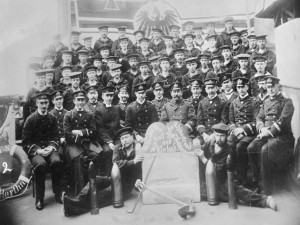
Officers and Men of SMS Hertha in China
Photo from
WikiCommons/Bundesarchiv
|
| |
|
|
|
S. M. S. HANSA
 |
|
These are two cap tallies from the
Matrosen and Werft personnel serving on SMS Hansa. SMS Hansa
was a protected cruiser of the Victoria Louise class launched in
1898.
She served in the East Asia Squadron
during the Boxer Rebellion of 1900 along with SMS Hertha, SMS
Iltis and SMS Gefion bombarded the Taku Forts. Her sailors then
took part in the successful storming of the forts.
During the Russo-Japanese War, SMS Hansa
(along with the protected cruiser SMS Fürst Bismarck, the gun
boats SMS Tiger and SMS
Luchs and the cruisers
Hertha and
Geier) took
part in the forcible internment of the Russian battleship Tsesarevich
and three destroyers at
Tsingtao
in 1904.
During the First World War she was used as
a floating barracks and was scrapped in 1920. |
|
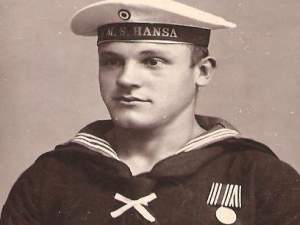
Sailor from the SMS Hansa
wearing the 1900 China Campaign Medal
Photo © JW Collection |
| |
|
|
|
S. M. S. ILTIS
 |
|
This is a cap tally from the
Matrosen personnel serving on the SMS Iltis (polecat).
SMS Iltis
was the first of six Iltis class of gunboats and was launched in 1898.
Her sister ships were the SMS Jaguar, SMS Tiger, SMS Luchs, SMS Panther and
SMS Eber. All six served overseas.
The Iltis served in the Boxer
Rebellion in China in 1900 and suffered heavy casualties from
Chinese artillery during the storming of the Taku Forts. For
this action the ship was awarded Prussia's highest decoration
for bravery, the Pour-le-Mérite (see
Prussian Medals).
This was the only occasion on which a ship rather than an
individual was awarded the honour.
After the rebellion the Iltis remained on
service in China as part of the
East Asia Fleet based at Tsingtao. She also stayed at Tsingtao
during the siege of 1914 (along with her sister ships the
gunboats SMS Jaguar, SMS Tiger and SMS Luchs,
the
light cruiser SMS Cormoran, the
minesweeper Lauting, the river gunboat Taku, the torpedo boat
S90 and the Austro-Hungarian protected cruiser SMS Kaiserin
Elisabeth). Aside from the S90, all were scuttled
in the harbour with their guns and
crew then fighting on land
until Tsingtao finally surrendered in November 1914.
The crew were then kept as Prisoners of War in Japan until the
end of the war.
Recommended External Link
-
Tsingtau
Info
|
|
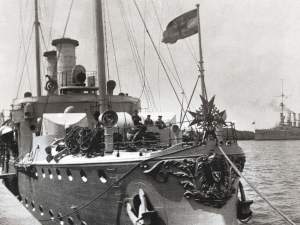
SMS Iltis showing the PLM cross
on her bow
Photo ©
Deceptico from his Grandfather's Collection |
| |
|
|
|
S. M. S. JAGUAR
 |
|
This is a cap tally from the
Matrosen personnel serving on the SMS Jaguar.
The Jaguar was an Iltis class gunboat launched in 1898
and along with three of her sister ships, was posted to China and the
German naval base at Tsingtao. The four Iltis class gunboats
were
scuttled in the harbour with their guns and crew then fighting on
land until Tsingtao finally
surrendered in November 1914. The crew
were then kept as Prisoners of War in Japan until the end of the
war. |
|
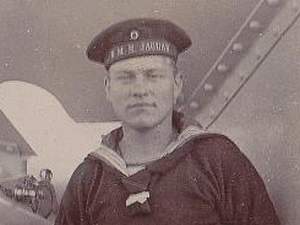
Sailor of the SMS Jaguar
Photo ©
Lovett Artillery |
| |
|
|
|
S. M. S. TIGER
 |
|
This is a cap tally from the
Matrosen personnel serving on the SMS Tiger.
The Tiger was an Iltis class gunboat launched in 1899
and along with three of her sister ships, was posted to China and the
German naval base at Tsingtao.
In the Russo-Japanese War SMS
Tiger took
part in the forcible internment of the Russian battleship Tsesarevich
and three destroyers at
Tsingtao
in 1904.
During the First World War, the
four Iltis class gunboats were
scuttled in Tsingtao harbour with their guns and crew then fighting on
land until the city finally
surrendered in November 1914. The crew
were then kept as Prisoners of War in Japan until the end of the
war.
|
|
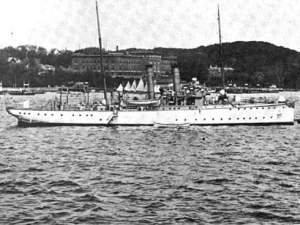
SMS Tiger
Photo from
WikiCommons |
| |
|
|
|
S. M. S. LUCHS
 |
|
These are two cap tallies from the
Matrosen and Werft personnel serving on the SMS Luchs (lynx).
The Luchs was an Iltis class gunboat launched in 1899
and along with three of her sister ships, was posted to China and the
German naval base at Tsingtao.
During the Russo-Japanese War, SMS
Luchs took
part in the forcible internment of the Russian battleship Tsesarevich
and three destroyers at
Tsingtao
in 1904.
During the First World War,
the four Iltis class gunboats were
scuttled in Tsingtao harbour with their guns and crew then fighting on
land until the city finally
surrendered in November 1914. The crew
were then kept as Prisoners of War in Japan until the end of the
war. |
|
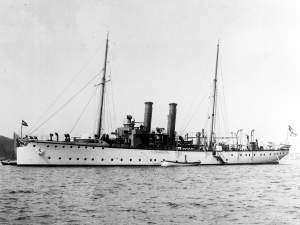
SMS Luchs
Photo by Arthur Renard
from
WikiCommons |
| |
|
|
|
S. M. S. PANTHER
 |
|
These are two cap tallies from the
Matrosen and Werft personnel serving on the SMS Panther.
SMS Panther
was an Iltis class gunboat launched in 1901. She was involved in
several examples of overseas Gunboat Diplomacy.
In 1902
she sailed to Haiti to destroy a Haitian rebel gunboat which had
itself captured a German steamer. This action could potentially
have caused offence in America, contradicting the Monroe
Doctrine of opposing European encroachments on the Americas but
no action was taken.
In 1902-03 she
served as part of the allied (British, German and Italian) fleet
taking part in the blockade of Venezuelan ports in 1902-03. In
January 1903 she bombarded Venezuelan Fort San Carlos. On this
occasion the United States did take offence and sent a fleet to
warn
In 1911
the Panther was sent to the port of Agadir to protect German
civilians and to put pressure on any French claims on territory, in what became known as the Agadir or Second Moroccan
Crisis. War was averted only by negotiation between the European Powers once
again settled in favour of France (who took full control of
Morocco the following year). Germany was placated with former
French territory in the Congo added to German Cameroon.
Recommended
External Link -
Black's Academy |
|
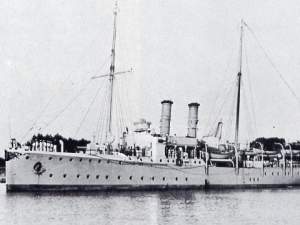
SMS Panther
Photo from
WikiCommons |
| |
|
|
|
S. M. S. EBER
 |
|
This is a cap tally from the
Matrosen personnel serving on the SMS Eber (boar or hog).
The first gunboat Eber was launched
in 1887 and served in Samoa the following year. Along with the
Adler she was wrecked in a storm at Apia in 1889.
The second SMS Eber
was the last of the Iltis class gunboats launched in 1902. She
was posted to the German colonies of West Africa. When the First
World War broke out she sailed from German South West Africa to
Brazil. There she transferred her guns and most of the crew to
arm the steamer Cap Trafalgar for a raiding career.
The Eber was then interned in Brazil where she was eventually
scuttled to avoid capture when Brazil declared war on Germany in
1917.
Recommended External Link-
Axis History Forum Post on the SMS Eber in Brazil |
|
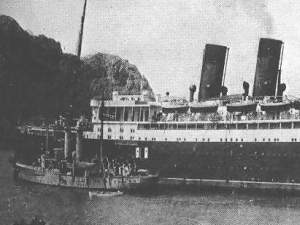
SMS Eber alongside the much
larger Cap Trafalgar, Brazil 1914
Photo from
WikiCommons |
| |
|
|
|
S. M. S. KOENIGSBERG
 |
|
This is a cap tally from the
Werft personnel serving on the SMS Königsberg (the former
capital of East Prussia, now known as Kaliningrad in Russia).
There were two German ships in the First World War with this
title.
The first and more famous of
the two was a Königsberg class light cruiser, launched in 1905
and stationed off East Africa when the First World War broke
out. Initially she raided allied shipping in the Indian Ocean
and sank the British ship SMS Pegasus in Zanzibar harbour. She
was then forced to seek refuge in the Rufiji Delta in need of
engine repairs. There she was trapped and sunk by monitors of
the Royal Navy in 1915. Her crew and guns then fought alongside
the Schutztruppe in the land campaign in East Africa (see
Königsberg Guns Page).
A second
light cruiser named SMS Königsberg was launched in Germany later
in 1915 and took part in the Operation Albion landings in the
Gulf of Latvia in 1917. After the war she entered French service
as the Metz and was scrapped in 1936.
This pristine condition tally was
most likely issued to a member of the second ship's crew. Or it
may have been privately made after the war for a veteran of the
first SMS Königsberg. |
|
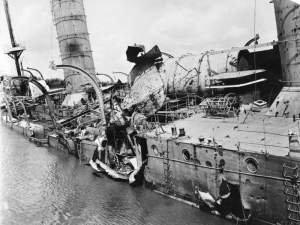
SMS Königsberg
destroyed in the
Rufiji Delta, 1915
Photo by Walter
Dobbertin from
WikiCommons/Bundesarchiv |
| |
|
|
|
S. M. S. EMDEN
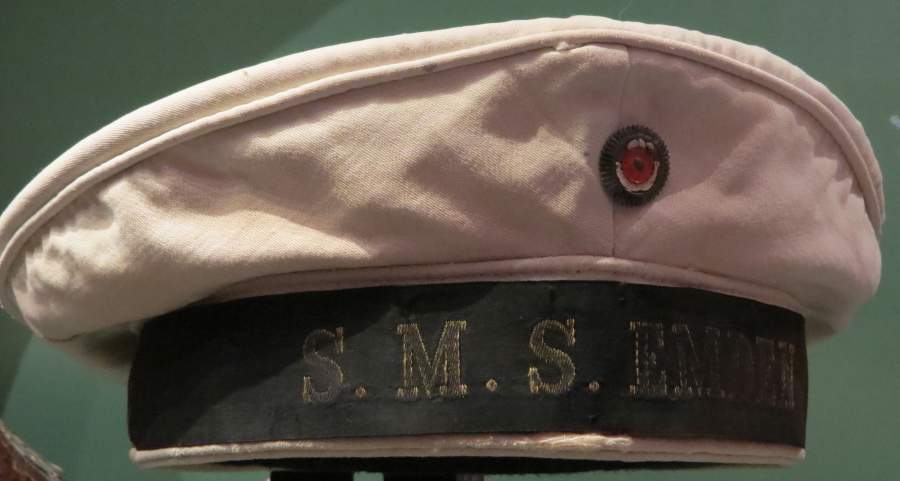
Photo by Sebastien
Grenda at the Australian War Memorial, Canberra |
| |
|
|
| A white
naval cap from the SMS Emden bearing the gold lettering of the
Matrosen on the tally. The
SMS Emden was a Dresden class light cruiser launched in 1908 and
posted to the East Asia squadron based at Tsingtao in 1910. She
took part in the suppression of the Sokehs Rebellion on Ponape
in 1910-11 and in 1913 (along with British and Japanese ships)
shelled a rebel Chinese fort on the Yangtze.
When the First World War broke
out the Emden, under the command of Korvettenkapitän Karl von
Müller, set sail from Tsingtao to cause mayhem amongst allied
shipping in the Indian Ocean and bombard enemy ports (including
Madras in British India). The allies put vast efforts into
catching the SMS Emden (at one point having over 60 warships
involved in the search) but she eluded them, capturing and
sinking thousands of tons of Entente shipping along the way. In
November 1914 she was finally cornered off the Cocos Islands and
sunk by the Australian light cruiser HMAS Sydney. The surviving
crew of the SMS Emden were uniquely honoured for their bravery
by being allowed to add the suffix '-Emden' to their surnames.
To this day some of their descendants still carry this
additional name.
Recommended External
Link - History Net page on the
SMS Emden |
|
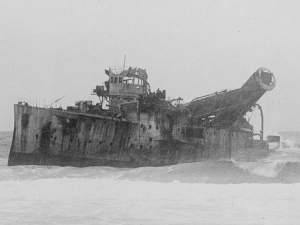
Wreck of SMS Emden off
North Keeling Island
Photo by
Allan C Green,
State Library
of Victoria/WikiCommons |
| |
|
|
|
S. M. S.
AYESHA
 |
|
This is a cap tally from the
Matrosen personnel serving on the SMS Ayesha. No tallies were
made for the crew at the time, this would be a post war item
probably made to recognise a veteran of the Ayesha.
The Ayesha was a three masted
schooner, captured by the SMS Emden and used by their landing
party to sail a desperate mission across the Indian Ocean from
the Cocos Islands to Dutch Sumatra and from there to a
rendezvous with the North German Lloyd steamer Choising. The
Ayesha was scuttled and the crew made their way to the Arabian
Peninsular and Ottoman territory. Along the way the crew met
many hardships including a dire shortage of provisions and
attacks by Arab bandits.
They eventually returned to
Germany and were decorated by the Kaiser himself. Their exploits
are recorded in the film 'Die
Männer der Emden'
-the Men of the Emden' |
|
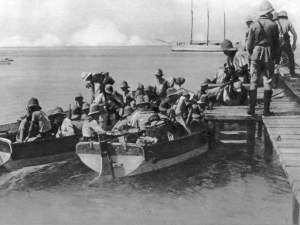
Crew of the SMS Emden with
SMS Ayesha in the Background
Photo from
Illustrated War News - Part 21 |
| |
|
|
|
S. M. S. GOEBEN
 |
|
These are three cap tallies from SMS
Goeben (named after the Prussian general of the Franco-Prussian
War, August Karl von Goeben). The top and bottom are from the
Matrosen and Werft personnel under German command. The centre
one is from when the ship was under nominal Ottoman Turkish
command. The SMS
Goeben was the second of two Moltke
class battle cruisers and was launched in 1911. At the outbreak
of the First World War, she formed the German Mediterranean Sea
Division along with the light cruiser SMS
Breslau. After bombarding the French bases at Bône and Philippeville in
Algeria they handed themselves over to the Ottoman navy rather
than surrender to the overwhelming power of the allied navies
in the Mediterranean. Once under the Ottoman flag they bombarded
the Russian ports of Sevastopol and Odessa thus precipitating a
Russian declaration of war on the Ottoman Empire thus bringing
them into the war on the German side. During the war the two
ships remained on patrol in the Black Sea while sailors from the
ships also served as machine gunners on the Gallipoli front.
Under the Ottoman flag the Goeben was renamed the TCG Yavuz Sultan Selim (after Sultan Selim I) and
remained in Turkish service until 1950 (being renamed TCG Yavuz
in 1936). It was finally scrapped in 1973. |
|
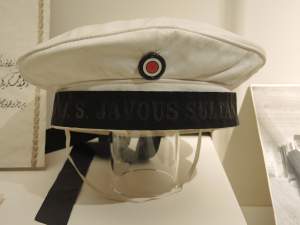
Cap for the SMS Goeben
in Ottoman Service
Photo from
Internationales Maritimes Museum Hamburg
©
Mark Schellenberg 2016 |
| |
|
|
|
S. M. S. BRESLAU
 |
|
These are two cap tallies from the
Matrosen personnel serving on the SMS Breslau (named after the
capital city of Prussian Silesia, now
Wrocław
in Poland). The top one is from when the ship was under German
command. The bottom one is from when the ship was under nominal
Ottoman Turkish command.
SMS Breslau was a Magdeburg class cruiser launched in 1911.
Together with the SMS Goeben, the Breslau formed the German
Mediterranean Division. The Breslau deployed the Marine
Detachment Skutari to Albania in 1913. In 1914 along with the
Goeben, she put herself under Ottoman command and was renamed
the TCG Midilli (the
Turkish name for the Aegean island of Lesbos). During the Battle
of Imbros off the Dardanelles in January 1918, she struck a
total of five mines and sank with most of her crew. The Second
World War German naval commander and briefly the last Führer of
the Third Reich served on the SMS Breslau. |
|
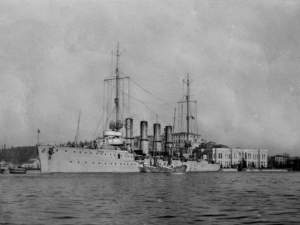
SMS Breslau
in Ottoman service as the
TCG Midilli
Photo from Bundesarchiv/WikiCommons |
| |
|
|
|
S. M.
TORPEDOBOOT S. 90.
 |
|
These are two cap tallies from the
Matrosen and Werft personnel serving on the SM Torpedoboot S. 90
The S90 was the first of a class of
ocean going torpedo boats (numbered 90-101) and was launched in
1899. She was part of the East Asian Squadron based at Tsingtao.
During the Siege of Tsingtao in
1914 she broke out through enemy lines firing torpedoes at
Japanese ships along the way and beached on the Chinese coast.
Her crew ended up interned at Nanking in neutral China. |
|
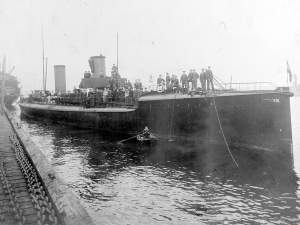
S90 in Kiel, 1901 |
|
|
|
|
|
S. M.
TORPEDOBOOT TAKU
 |
|
These are two cap tallies from the
Matrosen and Werft personnel serving on the torpedo boat Taku.
The Taku was made in Germany in 1898
for sale to the Chinese government. It was then captured from
the Chinese during the Boxer Rebellion and thenceforth used by
the German Imperial Navy to serve from Tsingtao in Chinese
coastal waters and along the River Yangtze. From 1902 she was
armed with two 5cm guns and two torpedo tubes.
When the first World War broke
out the Taku was in Tsingtao having been damaged in a grounding
the previous year. On 29 September 1914 she was scuttled and her
guns and crew served on land. After the fall of Tsingtao the
survivors became prisoners of war in Japan.
|
|
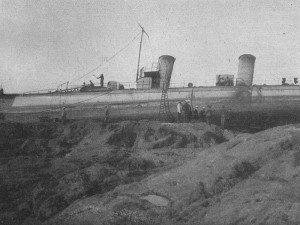
Torpedo Boat Taku run
aground, 1913
Photo from
WikiCommons |
| |
|
|
|
S. M. S. SHAMIEN
 |
|
These are two cap tallies from the
Matrosen and Werft personnel serving on the SMS Shamien.
The Shamien (sometimes spelled Schamien
on tallies)
was a small (24metre) Chinese river boat built in 1899 as Tong
Cheong for the Kowloon-dock Company in Hong Kong and
commissioned into German service on 20 October 1900 as the first
German river gunboat in China.
She was equipped and crewed by
twelve men of the SMS Luchs (and six Chinese sailors). She
served on the Pearl River at Canton until February 1904 when she
was sold and replaced by the SMS Tsingtao. |
|
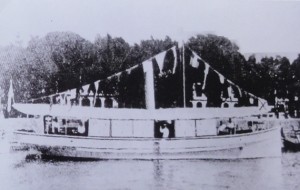
SMS Shamien |
| |
|
|
|
S. M. S. VATERLAND
 |
|
These are two cap tallies from the
Matrosen and Werft personnel serving on the SMS Vaterland.
SMS Vaterland was a river gunboat
made in Germany and shipped in sections to Shanghai where she
was assembled in 1904 along with her sister ship SMS Tsingtao.
The Vaterland joined British and French vessels patrolling the
River Yangtze and was involved in putting down several incidents
of local unrest.
When the First World War broke
out, SMS Vaterland was left at Nanjing with a small crew, while
the bulk of her men made the journey overland to join the
defenders of Tsingtao. When China decaled war on Germany in
1917, the Vaterland was was seized. After the First World War
she served in the Chinese and from 1935 in the Manchukuo Navy
under the name Li Sui. |
|
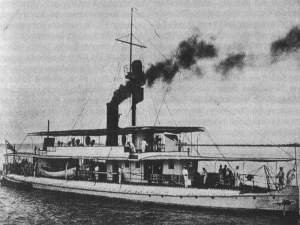
SMS Vaterland as the Li Sui
in Chinese Service
Photo from
WikiCommons |
| |
|
|
|
MATR. ART. DETACHMENT KIAUTSCHOU.
 |
This is a cap tally from the
Kiautschou Naval Artillery Detachment which was formed in 1898
at the same time as the III. Seebataillon to protect the newly
leased German territory of Kiautschou in China with its port of
Tsingtao.The single
artillery detachment of 1898 was expanded into several batteries
of heavy guns in land emplacements defending Tsingtao from land
and sea by 1914 . |
|
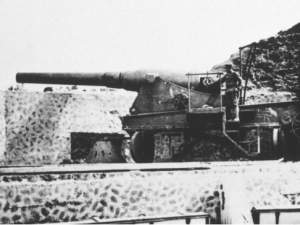
21cm Gun of the Tsingtao Naval Batteries 1914
Photo from Bundesarchiv /
WikiCommons |
| |
|
|
1. MATROSENARTILLERIE KIAUTSCHOU. 1.
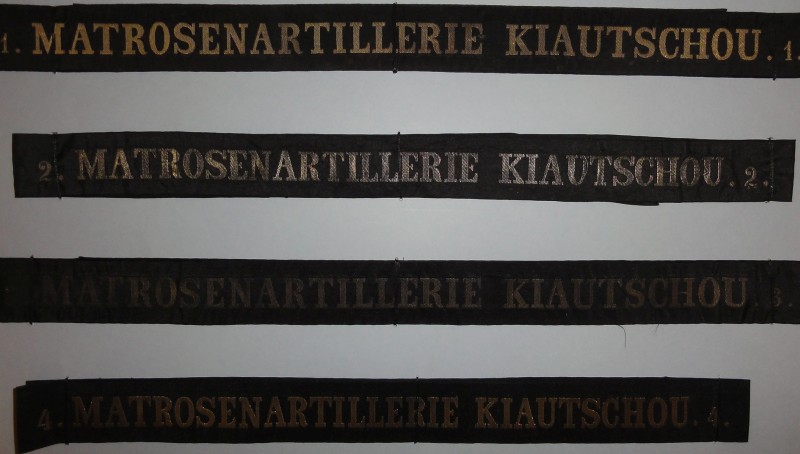 |
Here are cap tallies from the
four naval artillery companies that were based at the German territory of
Kiautschou in China in 1914.
The Kiautschou Naval Artillery Detachment
was expanded from 1902 into two artillery companies. This was
dispalyed on a cap tallies as "1. MATROSENARTILLERIE KIAUTSCHOU. 1."
and "2. MATROSENARTILLERIE KIAUTSCHOU. 2." respectively. In 1905
a third company was added and in 1906 a fourth, each with
corresponding tallies.
In 1909 a depot company of the
Kiautschou Artillery was formed and wore the same cap tally but
without the company numbers.
In 1914 volunteers and reservists
joining the Kiautschou naval artillery wore a letter E for
Ersatzkompanie on thier tallies as "E. MATROSENARTILLERIE KIAUTSCHOU.
E."
|
|
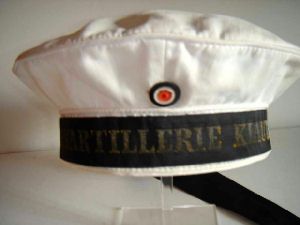
Cap from the Depot Company,
without numbers
MATROSENARTILLERIE
KIAUTSCHOU
Photo © Doppler Collection |
| |
|
|
|
GOUVERNEMENT KIAUTSCHOU
 |
| These are two cap tallies from personnel
serving in the Kiautschou government.
Unlike other overseas possessions, the German territory of
Kiautschou in China (including the port
of Tsingtao) was directly governed by the
Imperial navy.
From 1900 other ranking personnel of the naval
government wore these cap tallies. |
|
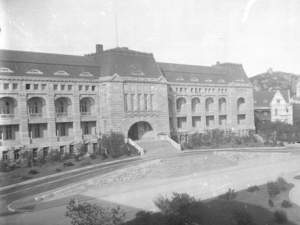
Governor's Palace, Tsingtao
Photo from Bundesarchiv/WikiCommons |
| |
|
|
|
SONDERKOMMANDO DARDENELLEN
 |
| This is
a cap tally from the Sonderkommando Dardenellen (Dardanelles
naval support command).
This was a specialist naval unit under Admiral Usedom, consisting of five
hundred naval artillery officers and men sent out to assist and fight
alongside the Turkish artillery at the Dardanelles Straights in
1914. It was this additional expertise along with German Krupp
guns, that made the Turkish artillery so deadly to the British,
ANZAC and French forces at Gallipoli.
Recommended External Link -
Gallipoli1915.de
|
|
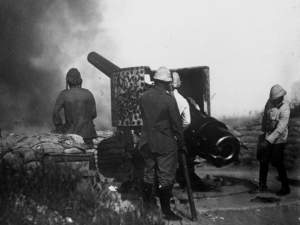
Turkish Krupp Artillery under
German Command, Dardanelles
Photo from
WikiCommons/Bundesarchiv |
| |
|
|
|
MARINE FELD COMP. = DEUTSCH OST AFRIKA
 |
|
This is a cap tally fro a veteran
of a Naval Field Company in German East Africa.
During the First
World War sailors from several merchant and navy vessels stranded in East Africa
(such as the SMS Königsberg and SMS Möwe) were formed into
units to fight alongside the Schutztruppe. Most of the
Königsberg's crew formed an Abteilung at Dar Es Salaam, while
the Möwe crew fought on Lake Tanganyika.
It is very unlikely
however that they made their own tallies in Africa and so this
example was almost certainly made for a veteran after the war. |
|
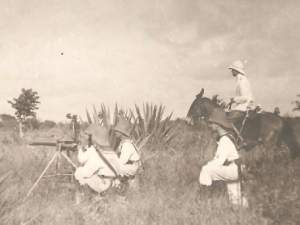
German Sailors training in
East Africa c1915
Photo
© Peter Klein |